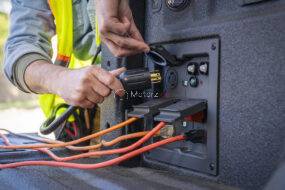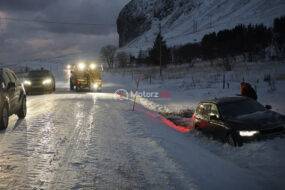Here are some essential tips to help you stay safe and confident on Canadian roads this winter:
Before You Hit the Road:
Winterize Your Vehicle: Ensure your Safe Journey for New Canadians is equipped for winter driving. This includes:
Winter Tires: Invest in a set of winter tires with good tread depth. They provide superior traction on snow and ice.
Tire Pressure: Check your tire pressure regularly, as it can fluctuate in cold temperatures.
Windshield Washer Fluid: Use winter-grade windshield washer fluid that won’t freeze.
Emergency Kit: Keep an emergency kit in your car with essentials like blankets, food, water, a flashlight, jumper cables, and a first-aid kit.
Learn Winter Driving Techniques: Take a winter driving course to learn proper techniques for braking, steering, and accelerating on slippery surfaces.
Plan Your Route: Check weather conditions and road closures before you start your journey. Use navigation apps or websites to find alternative routes if necessary.
Inform Someone of Your Plans: Let a friend or family member know your destination and expected arrival time.
While You’re Safe Journey for New Canadians:
Slow Down: Reduce your speed significantly on icy or snowy roads. Braking too hard can cause your vehicle to skid.
Maintain a Safe Distance: Follow the two-second rule: Maintain a distance of two seconds between your Safe Journey for New Canadians and the one in front of you. This allows you more time to react if necessary.
Be Gentle with Your Movements: Avoid sudden braking, acceleration, or steering. Smooth movements help maintain control.
Use Low Gear: Driving in a lower gear can help prevent your wheels from slipping on icy roads.
Beware of Black Ice: Black ice is a thin layer of ice that is difficult to see. Be extra cautious on bridges, overpasses, and shaded areas.
Avoid Distractions: Keep your eyes on the road and avoid distractions like using your phone or eating while driving.
Be Patient: Winter driving can be stressful, but it’s important to remain calm and patient.
If You Get Stuck:
Stay in Your Vehicle: If your vehicle becomes stuck, it’s generally safer to stay inside and wait for help.
Turn on Hazard Lights: Turn on your hazard lights to alert other drivers.
Stay Warm: Use blankets and layers of clothing to stay warm.
Conserve Fuel: Limit the use of your heater to conserve fuel.
Call for Help: If you can’t free your vehicle yourself, call for roadside assistance or emergency services.
Remember, winter driving requires extra attention and preparation. By following these tips and driving defensively, you can stay safe and enjoy your Safe Journey for New Canadians adventures.
Understanding Unique Canadian Conditions:
Varied Climates: Safe Journey for New Canadians vast geography means diverse winter conditions. From heavy snowfall in the Prairies to icy rain in the East, understanding regional peculiarities is crucial.
Black Ice: A particular danger is black ice, which is nearly invisible and can cause sudden loss of control. Be especially cautious on bridges, overpasses, and shaded areas.
Whiteouts: Severe snowstorms can create whiteouts, making visibility near-zero. If caught in one, find a safe spot to pull off the road and wait for conditions to improve.
Advanced Vehicle Preparation:
Winter Fluids: In addition to windshield washer fluid, ensure your Safe Journey for New Canadians is rated for temperatures below freezing.
Battery Health: Cold weather can strain your car’s battery. Have it tested regularly and consider a battery warmer if necessary.
Emergency Kit Essentials: Beyond the basics, include items like a snow shovel, traction aids (like sand or cat litter), and a reflective warning triangle.
Defensive Driving Techniques:
Anticipate Hazards: Be constantly aware of potential hazards, such as slippery patches, snowbanks, and other drivers who may be struggling.
Brake Gradually: Apply brakes smoothly and progressively to avoid locking up your wheels, especially on icy roads.
Avoid Overcorrection: If your Safe Journey for New Canadians starts to skid, resist the urge to overcorrect. Instead, steer gently in the direction of the skid.
Use Low Gears: Driving in lower gears can provide better traction and control on slippery surfaces.
Specific Scenarios:
Hill Driving: Avoid stopping on hills if possible. If you must stop, engage the parking brake and turn your wheels toward the curb to prevent rolling back.
Snowstorms: If caught in a snowstorm, find a safe place to pull off the road. Turn on your hazard lights and wait for conditions to improve.
Road Closures: Be aware of road closures and Safe Journey for New Canadians, especially in remote areas. Plan your route in advance and check for updates before leaving.
Additional Considerations:
Winter Driving Courses: Consider taking a winter driving course to learn advanced techniques and gain confidence.
Local Knowledge: If you’re new to a Safe Journey for New Canadians city, ask locals for advice on winter driving conditions and recommended routes.
Stay Informed: Pay attention to weather forecasts and road conditions. Many provinces have websites and apps that provide real-time updates.
By following these tips and driving defensively, you can significantly increase your safety and enjoyment of winter driving in Canada.





